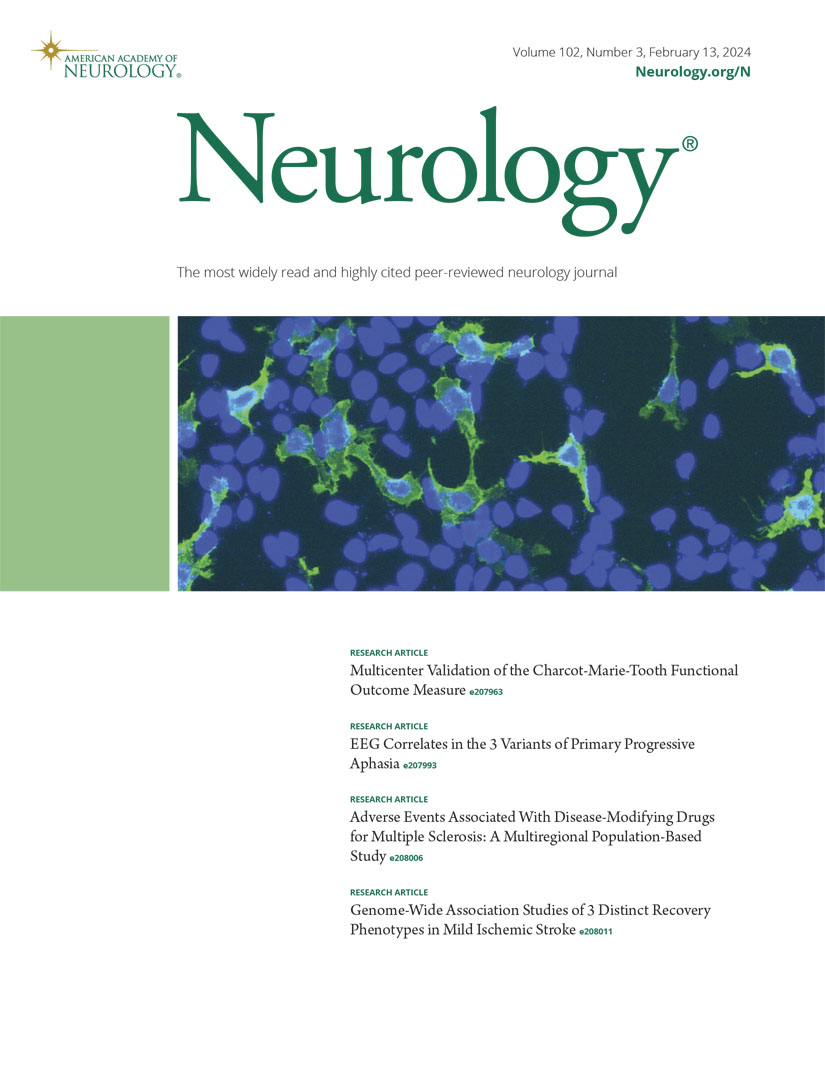Automated Whole-Brain Focal Cortical Dysplasia Detection Using MR Fingerprinting With Deep Learning.
IF 7.7
1区 医学
Q1 CLINICAL NEUROLOGY
引用次数: 0
Abstract
BACKGROUND AND OBJECTIVES Focal cortical dysplasia (FCD) is a common pathology for pharmacoresistant focal epilepsy, yet detection of FCD on clinical MRI is challenging. Magnetic resonance fingerprinting (MRF) is a novel quantitative imaging technique providing fast and reliable tissue property measurements. The aim of this study was to develop an MRF-based deep-learning (DL) framework for whole-brain FCD detection. METHODS We included patients with pharmacoresistant focal epilepsy and pathologically/radiologically diagnosed FCD, as well as age-matched and sex-matched healthy controls (HCs). All participants underwent 3D whole-brain MRF and clinical MRI scans. T1, T2, gray matter (GM), and white matter (WM) tissue fraction maps were reconstructed from a dictionary-matching algorithm based on the MRF acquisition. A 3D ROI was manually created for each lesion. All MRF maps and lesion labels were registered to the Montreal Neurological Institute space. Mean and SD T1 and T2 maps were calculated voxel-wise across using HC data. T1 and T2 z-score maps for each patient were generated by subtracting the mean HC map and dividing by the SD HC map. MRF-based morphometric maps were produced in the same manner as in the morphometric analysis program (MAP), based on MRF GM and WM maps. A no-new U-Net model was trained using various input combinations, with performance evaluated through leave-one-patient-out cross-validation. We compared model performance using various input combinations from clinical MRI and MRF to assess the impact of different input types on model effectiveness. RESULTS We included 40 patients with FCD (mean age 28.1 years, 47.5% female; 11 with FCD IIa, 14 with IIb, 12 with mMCD, 3 with MOGHE) and 67 HCs. The DL model with optimal performance used all MRF-based inputs, including MRF-synthesized T1w, T1z, and T2z maps; tissue fraction maps; and morphometric maps. The patient-level sensitivity was 80% with an average of 1.7 false positives (FPs) per patient. Sensitivity was consistent across subtypes, lobar locations, and lesional/nonlesional clinical MRI. Models using clinical images showed lower sensitivity and higher FPs. The MRF-DL model also outperformed the established MAP18 pipeline in sensitivity, FPs, and lesion label overlap. DISCUSSION The MRF-DL framework demonstrated efficacy for whole-brain FCD detection. Multiparametric MRF features from a single scan offer promising inputs for developing a deep-learning tool capable of detecting subtle epileptic lesions.基于深度学习的磁共振指纹自动全脑局灶性皮质发育不良检测。
背景与目的局灶性皮质发育不良(FCD)是耐药局灶性癫痫的常见病理,但临床MRI检测FCD具有挑战性。磁共振指纹(MRF)是一种新型的定量成像技术,可提供快速、可靠的组织特性测量。本研究的目的是开发一种基于磁共振成像的深度学习(DL)框架,用于全脑FCD检测。方法我们纳入了顽固性局灶性癫痫和病理/放射诊断为FCD的患者,以及年龄匹配和性别匹配的健康对照(hc)。所有参与者都进行了3D全脑磁共振成像和临床MRI扫描。基于磁共振成像采集的字典匹配算法重建T1、T2、灰质(GM)和白质(WM)组织分数图。为每个病变手动创建3D ROI。所有磁共振成像图和病变标签都注册到蒙特利尔神经学研究所空间。使用HC数据按体素计算Mean和SD T1和T2图。每个患者的T1和T2 z评分图是通过减去平均HC图并除以SD HC图生成的。基于MRF的形态测量图以与形态测量分析程序(MAP)相同的方式生成,基于MRF GM和WM图。使用不同的输入组合训练了一个无新U-Net模型,并通过留下一个患者的交叉验证来评估其性能。我们使用临床MRI和MRF的不同输入组合来比较模型的性能,以评估不同输入类型对模型有效性的影响。结果纳入40例FCD患者,平均年龄28.1岁,女性47.5%;FCD 11例(IIa), IIb 14例,mMCD 12例,MOGHE 3例),HCs 67例。具有最佳性能的DL模型使用了所有基于mrf的输入,包括mrf合成的T1w, T1z和T2z映射;组织分数图;还有形态测量图。患者水平敏感性为80%,平均每个患者有1.7个假阳性(FPs)。敏感性在亚型、脑叶位置和病变/非病变临床MRI中是一致的。使用临床图像的模型灵敏度较低,FPs较高。MRF-DL模型在敏感性、FPs和病变标记重叠方面也优于已建立的MAP18管道。MRF-DL框架显示了全脑FCD检测的有效性。单次扫描的多参数MRF特征为开发能够检测细微癫痫病变的深度学习工具提供了有希望的输入。
本文章由计算机程序翻译,如有差异,请以英文原文为准。
求助全文
约1分钟内获得全文
求助全文
来源期刊

Neurology
医学-临床神经学
CiteScore
12.20
自引率
4.00%
发文量
1973
审稿时长
2-3 weeks
期刊介绍:
Neurology, the official journal of the American Academy of Neurology, aspires to be the premier peer-reviewed journal for clinical neurology research. Its mission is to publish exceptional peer-reviewed original research articles, editorials, and reviews to improve patient care, education, clinical research, and professionalism in neurology.
As the leading clinical neurology journal worldwide, Neurology targets physicians specializing in nervous system diseases and conditions. It aims to advance the field by presenting new basic and clinical research that influences neurological practice. The journal is a leading source of cutting-edge, peer-reviewed information for the neurology community worldwide. Editorial content includes Research, Clinical/Scientific Notes, Views, Historical Neurology, NeuroImages, Humanities, Letters, and position papers from the American Academy of Neurology. The online version is considered the definitive version, encompassing all available content.
Neurology is indexed in prestigious databases such as MEDLINE/PubMed, Embase, Scopus, Biological Abstracts®, PsycINFO®, Current Contents®, Web of Science®, CrossRef, and Google Scholar.
 求助内容:
求助内容: 应助结果提醒方式:
应助结果提醒方式:


